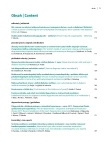Myocardial injury after carbon monoxide intoxication in suicide attempt, with features of both toxic and tako-tsubo cardiomyopathy: case report
Authors:
Radek Vančata 1; Jan Lhotský 1; Václav Beránek 1; Josef Krištof 2; Richard Rokyta 1
Authors‘ workplace:
Komplexní kardiovaskulární centrum – kardiologické oddělení, FN Plzeň, pracoviště Lochotín
1; Klinika anesteziologie, resuscitace a intenzivní medicíny LF UK a FN Plzeň
2
Published in:
Vnitř Lék 2018; 64(7-8): 797-801
Category:
Case Reports
Kazuistika byla prezentována ve zkrácené podobě jako poster na XXV. výročním sjezdu České kardiologické společnosti v Brně 7. 5.–10. 5. 2017.
Overview
Severe carbon monoxide intoxication may cause tissue injury by hypoxemia and histotoxicity. The affection of the heart muscle often leads to transient global or regional systolic dysfunction of left ventricle or both ventricles and increased occurences of malignant arrhytmias. On the contrary, stress-induced cardiomyopathy is described as temporary segmental loss of contractility, mostly in apical segments of the left ventricle with mid- and basal sparing and less common hypokinesias in mid- or basal parts, or affection of both ventricles. This case report is dedicated to a 34-years old male, who was admitted to the department of emergency medicine after suicide attempt by carbon monoxide poisoning. Echocardiography at admission showed akinesias of midsegments of left ventricle and severe hypokinesias of apical and basal segments. Despite severe cardiogenic shock, adequate therapeutic management including mechanical ventilation, normobaric oxygenotherapy and catecholamine treatment led to a complete somatic recovery after 2 weeks, and without any permanent hypoxemic brain injury. Our case might be a coincidence of toxic cardiomyopathy, caused by carbon monoxide poisoning, and takotsubo cardiomyopathy as a result of long term exposition to combined stress factors that may lead even to a suicide attempt. Both types of cardiomyopathies often occure simultaneously due to similar pathophysiologic mechanisms. Both tako-tsubo and toxic cardiomypathy have good prognosis after overcoming the acute phase.
Key words:
carbon monoxide – cardiogennic shock – cardiomyopathy – suicide – tako-tsubo cardiomypathy
Sources
- Hájek M. Diagnostický a léčebný standard otravy oxidem uhelnatým. Anesteziologie, resuscitace a intenzivní medicína. Referátový výběr z anesteziologie, resuscitace a intenzivní medicíny 2009; 56(6): 393–402.
- Hampson NB, Piantadosi CA, Thom SR et al. Practice recommendations in the diagnosis, management, and prevention of carbon monoxide poisoning. Am J Respir Crit Care Med 2012; 186(11): 1095–1101. Dostupné z DOI: <http://dx.doi.org/10.1164/rccm.201207–1284CI>.
- Scheinkestel CD, Bailey M, Myles PS et al. Hyperbaric or normobaric oxygen for acute carbon monoxide poisoning: a randomised controlled clinical trial. Med J Aust 1999; 170(5): 203–210.
- Weaver LK, Hopkins RO, Chan KJ et al. Hyperbaric oxygen for acute carbon monoxide poisoning. N Engl J Med 2002; 347(14): 1057–1067. Dostupné z DOI: <http://dx.doi.org/10.1056/NEJMoa013121>.
- Smithline HA, Ward KR, Chiulli DA et al. Whole body oxygen consumption and critical oxygen delivery in response to prolonged and severe carbon monoxidy poisoning. Resuscitation 2003; 56(1): 97–104.
- Dziewierz A, Ciszowski K, Gawlikovski T et al. Primary angioplasty in patient with ST-segment elevation myocardial infarction in the settling of intentional carbon monoxide poisoning. J Emerg Med 2013; 45(6): 831–834. Dostupné z DOI: <http://dx.doi.org/10.1016/j.jemermed.2013.05.061>.
- Lippi G, Rastelli G, Meschi T et al. Pathophysiology, clinics, diagnosis and treatment of heart involvement in carbon monoxide poisoning. Clin Biochem 2012; 45(16–17): 1278–1285. Dostupné z DOI: <http://dx.doi.org/10.1016/j.clinbiochem.2012.06.004>.
- Prockop LD, Chichkova RI. Carbon monoxide intoxication: an updated review. J Neurol Sci 2007; 262(1–2): 122–130. Dostupné z DOI: <http://dx.doi.org/10.1016/j.jns.2007.06.037>.
- Tritapepe L, Macchiareli G, Rocco M et al. Functional and ultrastructural evidence of myocardial stunning after acute carbon monoxide poisoning. Crit Care Med 1998; 26(4): 797–801.
- Andre L, Boissiere J, Reboul C et al. Carbon monoxide pollution promotes cardiac remodelling and ventricular arrhytmia in healthy rats. Am J Respir Crit Care Med 2010; 181(6): 587–595. Dostupné z DOI: <http://dx.doi.org/10.1164/rccm.200905–0794OC>.
- Macmillan CS, Wildsmith JA, Hamilton WF Reversible increase in QT dispersion during carbon monoxide poisoning. Acta Anaesthesiol Scand 2001; 45(3): 396–397.
- Dallas ML, Yang Z, Boyle JP et al. Carbon monoxide induces cardiac arrhytmia via induction of the late Na+ current. Am J Respir Crit Care Med 2012; 186(7): 648–656. Dostupné z DOI: <http://dx.doi.org/10.1164/rccm.201204–0688OC>.
- Salih SB, Alenezi H, Alghamdi A. A case of first degree AV block in carbon monoxide poisoning. J Saudi Heart Assoc 2013; 25(4): 255–259. <http://dx.doi.org/10.1016/j.jsha.2013.05.004>.
- Bayramoglu A, Kocak AO, Akbas I et al. Reversible left bundle-branch block due to carbon monoxide poisoning: a case report. Am J Emerg Med 2016; 34(2): 342.e1–3. Dostupné z DOI: <http://dx.doi.org/10.1016/j.ajem.2015.06.034>.
- Jung YS, Lee JS, Min YG et al. Carbon monoxide-induced cardiomyopathy – epidemiology, clinical characteristics and prognosis. Circ J 2014; 78(6): 1437–1444.
- Mikail H, Hess S, Jessel L et al. Takotsubo and Takotsubo-like syndrome: A common neurogenic myocardial stunning pathway? Int J Cardiol 2013; 166(1): 248–250. Dostupné z DOI: <http://dx.doi.org/10.1016/j.ijcard.2012.09.116>.
- Fitzgerald RS, Deghani GA, Kiihl S. Autonomic regulation of organ vascular resistances during hypoxemia in the cat. Auton Neurosci 2013; 174(1–2): 21–30. Dostupné z DOI: <http://dx.doi.org/10.1016/j.autneu.2012.11.005>.
- Kuběna P, Bohatá Š, Maňoušek J et al. Takotsubo kardiomyopatie, klinické zkušenosti s onemocněním a jednoletá prognóza pacientů. Vnitř Lék 2015; 61(7–8): 619–625.
Labels
Diabetology Endocrinology Internal medicineArticle was published in
Internal Medicine

2018 Issue 7-8
Most read in this issue
- Low-carbohydrate diet in diabetes mellitus treatment
- Spironolactone in the treatment of hypertension: a neglected molecule
- Mesenchymal stem cells and type 1 diabetes treatment
- Controversies in the treatment of gout
